Niagara Falls Tunnel Tours Open to the Public, Beneath Old Hydroelectric Power Plant
Updated Jan. 6 2023, 3:49 p.m. ET
Seeing Niagara Falls is exciting enough in itself — but the falls recently became an even more exciting place to visit, as a tour of a tunnel under Niagara Falls' old hydroelectric power plant is now part of the experience.
Niagara Falls tunnel tours are now open to the public, inviting visitors to learn about the area’s history — as well as about the renewable energy that Niagara Falls produces.
A tunnel under Niagara Falls has opened to the public.
As reported by Smithsonian Magazine, in 2022, a new tunnel opened 180 feet below the Niagara Parks Power Station, on the Canadian side of the falls. Formerly known as the Canadian Niagara Power Company generating station, this hydroelectric power plant was once used to convert Niagara Falls’ water into electricity, according to the Niagara Falls Tourism website.
As the official Niagara Parks website notes, the tunnel beneath the Niagara Parks Power Station was first excavated in 1901, lit entirely by lanterns, and made using only pickaxes, shovels, and basic dynamite.
According to CNN, the Adams hydroelectric power plant was the first power plant to generate electricity from Niagara Falls, first opening in 1895. But the Niagara Parks Power Station (and the tunnel beneath it) were in use for about 100 years, from 1905 until 2006, as per the outlet. The station opened for tours years ago, but the tunnel has been closed for the past 16 years.
Now, the 2,200-foot-long tunnel has reopened as a museum and viewing point for visitors to the falls.
Niagara Falls tunnel tours are educational — and provide an incredible view.
During a tour of the tunnel, you will be essentially following the path that water used to travel through the tunnel. And you’ll not only learn more about the tunnel's history, but you’ll wind up seeing an incredible sight. The tunnel includes a viewing platform where you can take in a panoramic view of Horseshoe Falls, which is the biggest waterfall at Niagara Falls.
And because the tunnel is 180 feet underground, it is consistently chill in the tunnel at about 60 degrees Fahrenheit, even if it’s a hot day outside. Visitors will take a glass-enclosed elevator down to the tunnel, which is fully accessible to wheelchair users.
The Niagara Parks Power Station has actually been open for tours for years, and the new tunnel is now officially part of the price of regular admission to the power station. Ticket prices range from $18.25 to $38, depending on when you go and if you’d like a guided tour. Children 5 and under can go for free.
This new tunnel is not only an interesting way to see Horseshoe Falls from a unique and mesmerizing view, but it’s also an interesting opportunity to learn about the history of Niagara Falls being used to generate hydroelectric power, which started more than a century ago.
Is Niagara Falls still used to generate hydroelectric power?
According to the NY Power Authority, the Niagara Power Project currently diverts water from the Niagara River into two reservoirs, via a tunnel; when the water is released from these reservoirs, it generates hydroelectric power — a renewable source of energy.
The Niagara Power Project formally opened in 1961, by President John F. Kennedy. At the time, it was the “largest hydropower facility in the Western world,” as per NYPA.
If we were able to produce clean energy from a source as natural as running water so many years ago, there’s no reason we can’t continue to do so — on a much greater scale — today. With the COP27 climate change conference having coincided with the opening of this tunnel, hopefully world leaders will take this week to renew their commitments to transitioning to clean energy economies.
This article, originally published on Nov. 7, 2022, has been updated.

